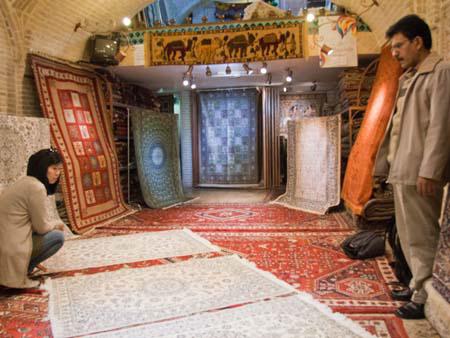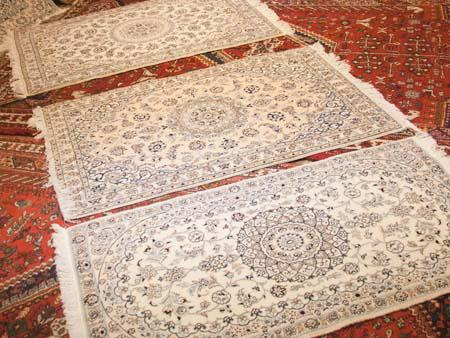Iran is famous for its handmade Persian carpets, and so prior to departing for Iran we decided we would pick up a carpet as a momentum.
We learnt a lot through visiting various shops where we were shown dozens of carpets, some were amazing, large and intricate in design (taking more than a years work to make and worth thousands of dollars) and even some nomadic carpets known as Gelim. We were informed that in general older carpets were worth more than those that were newer, and as such many people consider Persian rugs an investment.
After initially looking at many colours and designs, we decided we liked the pale cream coloured carpets with blue designs, which happened to be a common design made in Nain. Nain is located on the edge of the western desert and the pale cream colours represent the sandy deserts, and the blues the skies.
The base of a carpet can be cotton, wool or silk, with the price increasing in that order, silk carpets are much finer (number of knots per square centimetre) in comparison to wool carpets, resulting in more detailed designs and costlier carpets.
Nain carpets, these carpets have a cotton base, unlike the Isfahan carpets which are generally made with a silk base. In the end, we chose a wool/silk blend carpet, which is predominantly wool and with its intricate designs in white silk, a common approach in Nain carpets.
Nain carpets also use the common Persian Shah Abbas design, which is very similar to the mosaic floral designs on mosques of the Safavid dynasty.
After staring at three very similar Nain designs side-by-side (the shop keeper even mentioned side-by-side is a difficult choice, but at home individually they would all look good), we chose a beautiful 150 by 100 centimetres carpet. It cost us $310 USD which we were both very happy with, we shipped it to Australia for an additional $80 USD.
We recommend Ariana Carpet, Mr Asadi who was extremely informative and helpful.





































































































